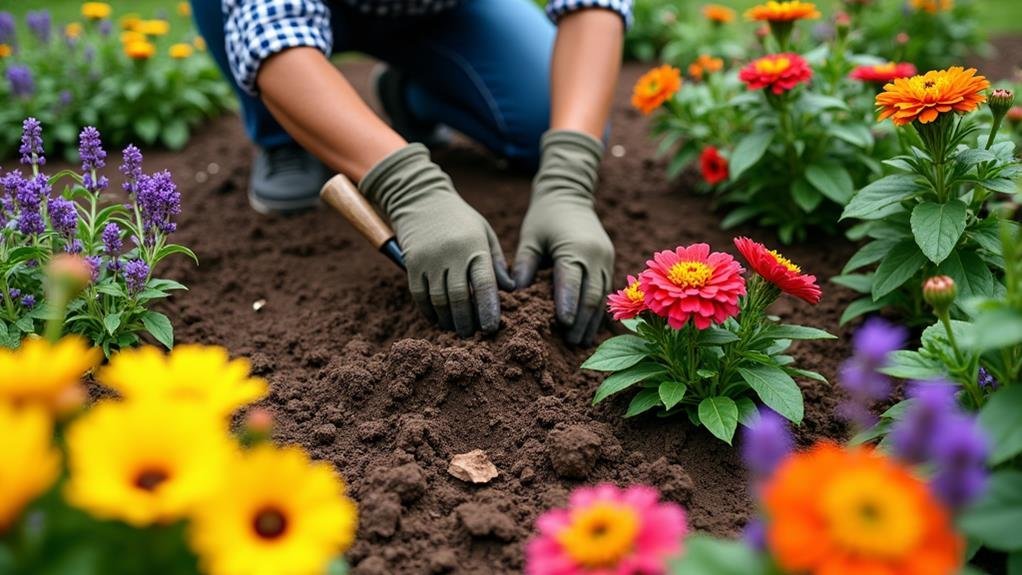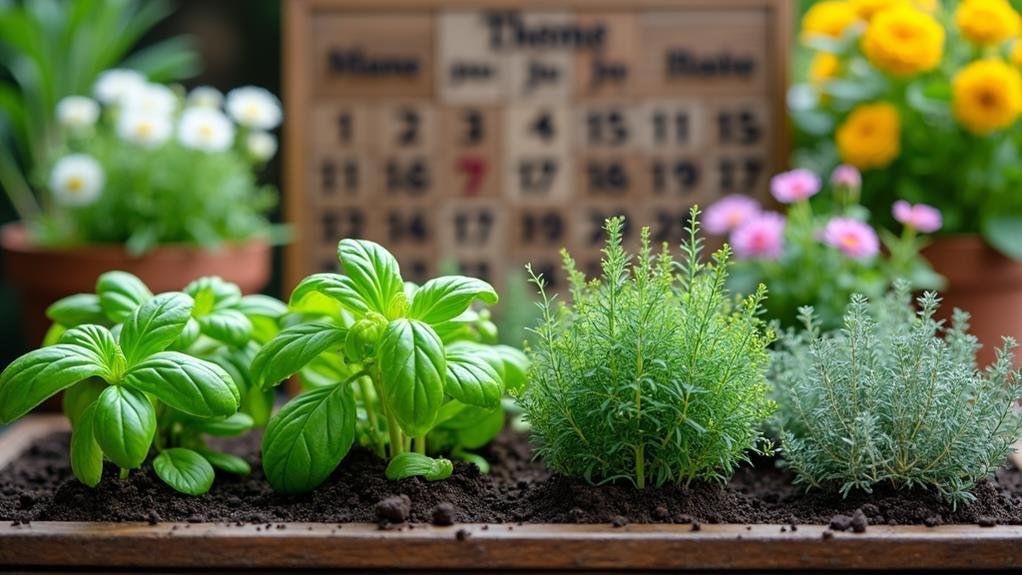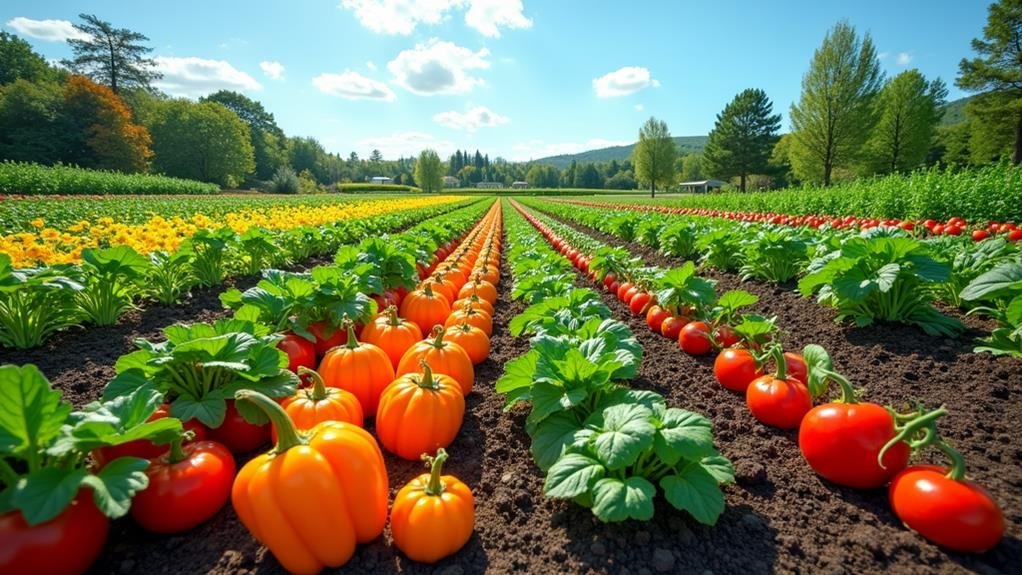When you're planning your garden, understanding the right timing for planting annuals and perennials can make all the difference. You need to know when to sow those vibrant annuals after the last frost and how perennials benefit from spring or fall planting. It's also crucial to take into account your regional climate, as this can dictate when you get started. With the right preparation, you can set the stage for a thriving garden. But before you grab your trowel, let's investigate how to guarantee your soil and layout are ideally ready.
Understanding Planting Seasons

Understanding the right planting seasons is essential for successful gardening. Knowing when to plant can make all the difference in how well your flowers and vegetables thrive. Each plant has its specific needs, and timing plays a vital role in their growth.
For instance, if you plant too early or too late, you risk exposing your plants to unfavorable weather, which can stunt their development or even kill them.
You'll want to pay attention to your local climate and hardiness zone. Typically, spring is the most popular season for planting, but fall can also be a great time for certain perennials.
Be sure to check the last frost date in spring and the first frost date in fall, as these will guide your planting schedule.
Soil temperature is another factor to keep in mind; some seeds germinate best at specific temperatures. Using a soil thermometer can help you determine if it's the right time to plant.
By understanding these seasonal guidelines, you're setting yourself up for a productive garden that blooms beautifully and yields a bountiful harvest.
Happy gardening!
Best Times for Annuals
In regards to planting annuals, timing is everything. You want to make certain that your flowers thrive and bloom beautifully throughout the season. Generally, the best time to plant annuals is after the last frost date in your area. Most annuals, like petunias and marigolds, love warm weather and should be planted when soil temperatures reach at least 60 degrees Fahrenheit.
If you're enthusiastic to get started, consider starting your seeds indoors about six to eight weeks before that last frost date. This way, you can give your plants a head start and transplant them outside once the weather's right.
Once you've planted your annuals, keep in mind that they'll need consistent watering, especially during dry spells.
For those living in warmer climates, you might've the luxury of planting annuals as early as mid-spring. However, if you're in a cooler region, it's best to wait until late spring.
Planting too early can expose your delicate blooms to frost damage, and nobody wants a sad garden. So, keep an eye on the weather, and you'll have a vibrant display of annuals in no time!
Ideal Periods for Perennials

Choosing the right time to plant perennials can make all the difference in creating a flourishing garden. Generally, the best times to plant perennials are in spring or fall.
In spring, after the last frost, the soil warms up, encouraging strong root growth. This period allows your plants to establish themselves before the heat of summer kicks in.
On the other hand, fall planting gives perennials a head start. The cooler temperatures and increased rainfall create ideal conditions for roots to grow. If you plant in the fall, make sure to do it early enough to allow the roots to establish before the ground freezes.
Keep in mind that some perennials benefit from being planted in late summer, especially in regions with milder winters. This timing can help them settle in before the cold sets in.
Regardless of when you choose to plant, verify you provide adequate water and care during their initial growth period.
Regional Timing Variations
Local climate plays a significant role in determining the best planting times for perennials and annuals. You'll want to take into account your region's frost dates, temperature patterns, and rainfall when planning your garden.
For example, if you live in a warmer southern area, you can often start planting annuals as early as March, while northern gardeners might wait until May.
In regions with distinct seasons, the timing can shift dramatically. In the Midwest, for instance, late spring is ideal for most annuals, while perennials can typically go in during fall or early spring.
Conversely, coastal areas might allow for year-round planting due to milder weather, but you still need to time your plants to avoid extreme heat in summer.
Don't forget to pay attention to local gardening calendars and community tips. They often provide insight into when specific plants thrive in your area.
By understanding your region's unique climate, you'll give your garden the best chance for success, ensuring vibrant blooms and healthy growth throughout the season.
Preparing for Planting Season

As spring approaches, it's time to get your garden ready for planting. Start by cleaning up your garden beds. Remove any dead leaves, weeds, or debris that may have accumulated over the winter. This not only clears the space but also helps prevent pests and diseases from taking hold.
Next, evaluate your soil. You might want to test its pH and nutrient levels to ascertain it's suitable for your plants. If it needs improvement, think about adding organic matter like compost or well-rotted manure. This will enrich your soil and promote healthy growth.
Also, plan your layout. Decide where you want to place your annuals and perennials based on their light and space requirements. Don't forget to take into account height and color for a visually appealing design. Consider creating a garden bed or border that features a variety of heights and colors to add interest. Additionally, make sure to plan for any herbs you want to include in your garden, and consider creating an herb planting schedule to ensure you have a steady supply of fresh herbs throughout the season. By carefully planning and arranging your garden layout, you can create a beautiful and functional outdoor space that you can enjoy for months to come.
Lastly, gather your tools and supplies. Make certain you have trowels, gloves, and watering cans ready to go. Organizing your supplies beforehand saves you time and keeps the planting process smooth and enjoyable.
With these preparations in place, you'll be set for a successful planting season!
Conclusion
To summarize, timing is key when planting annuals and perennials. By understanding the best seasons and regional variations, you can guarantee a thriving garden. Remember to prepare your soil and plan your layout for maximum growth. Whether you're getting your hands dirty in early spring or enjoying the autumn planting, following these guidelines will lead to a vibrant and healthy garden. Happy planting, and may your flowers bloom beautifully!




